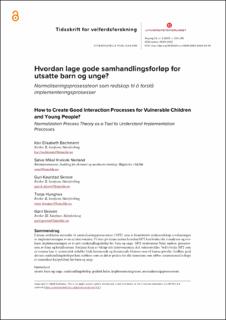| dc.contributor.author | Bachmann, Kari Elisabeth | |
| dc.contributor.author | Nerland, Sølve Mikal Krekvik | |
| dc.contributor.author | Skrove, Guri Kaurstad | |
| dc.contributor.author | Hungnes, Tonje | |
| dc.contributor.author | Groven, Gøril | |
| dc.date.accessioned | 2023-10-11T06:44:05Z | |
| dc.date.available | 2023-10-11T06:44:05Z | |
| dc.date.created | 2020-10-12T10:24:16Z | |
| dc.date.issued | 2020 | |
| dc.identifier.citation | Tidsskrift for velferdsforskning. 2020, 23 (3), 201-208. | en_US |
| dc.identifier.issn | 0809-2052 | |
| dc.identifier.uri | https://hdl.handle.net/11250/3095660 | |
| dc.description.abstract | I denne artikkelen anvender vi normaliseringsprosessteori (NPT) som et kvantitativt analyseredskap i evalueringen av implementeringen av en ny intervensjon. Vi viser på denne måten hvordan NPT kan brukes for å analysere og evaluere implementeringen av et nytt samhandlingsforløp for barn og unge. NPT strukturerer både analyse, presentasjon av funn og konklusjoner. Studiens funn er viktige når intervensjonen skal videreutvikles. Ved å bruke NPT som en ramme kan vi systematisk avdekke både hemmende og fremmende faktorer som vil kunne påvirke i hvilken grad det nye samhandlingsforløpet kan etableres som en del av praksis for alle tjenestene som jobber sammen med å skape et samordnet hjelpetilbud for barn og unge. Nøkkelord: utsatte barn og unge, samhandlingsforløp, psykisk helse, implementeringsteori, normaliseringsprosessteori | en_US |
| dc.description.abstract | The article describes the implementation of a new integrated care pathway in specialist care and in four municipalities, aimed at children and youngsters in need of coordinated care. The purpose of the pathway was to develop better routines for co-operation between families, municipality and specialist care. The approach of the analysis is the Normalization Process Theory. Questionnaire data were collected among leaders and employees. The main results show great willingness for change and commitment towards the integrated care pathway, and the respondents experience a great benefit from using the care pathway. However, there is also a need for critical assessment of which measures can further strengthen the implementation process. Critical conditions are how leaders in the participating organizations can provide for a collective implementation effort through strengthening of competence, guidance and resource allocations, supported by systematic assessments, training and exchange of experience. | en_US |
| dc.language.iso | nob | en_US |
| dc.relation.uri | https://doi.org/10.18261/issn.0809-2052-2020-03-04 | |
| dc.rights | Navngivelse-Ikkekommersiell 4.0 Internasjonal | * |
| dc.rights.uri | http://creativecommons.org/licenses/by-nc/4.0/deed.no | * |
| dc.title | Hvordan lage gode samhandlingsforløp for utsatte barn og unge : normaliseringsprosessteori som redskap til å forstå implementeringsprosesser | en_US |
| dc.title.alternative | How to create good tnteraction processes for vulnerable children and young people? : normalization process theory as a tool to understand implementation processes | en_US |
| dc.type | Peer reviewed | en_US |
| dc.type | Journal article | en_US |
| dc.description.version | publishedVersion | en_US |
| dc.source.pagenumber | 201-208 | en_US |
| dc.source.volume | 23 | en_US |
| dc.source.journal | Tidsskrift for velferdsforskning | en_US |
| dc.source.issue | 3 | en_US |
| dc.identifier.doi | 10.18261/issn.0809-2052-2020-03-04 | |
| dc.identifier.cristin | 1838803 | |
| cristin.ispublished | true | |
| cristin.fulltext | original | |
| cristin.qualitycode | 1 | |

